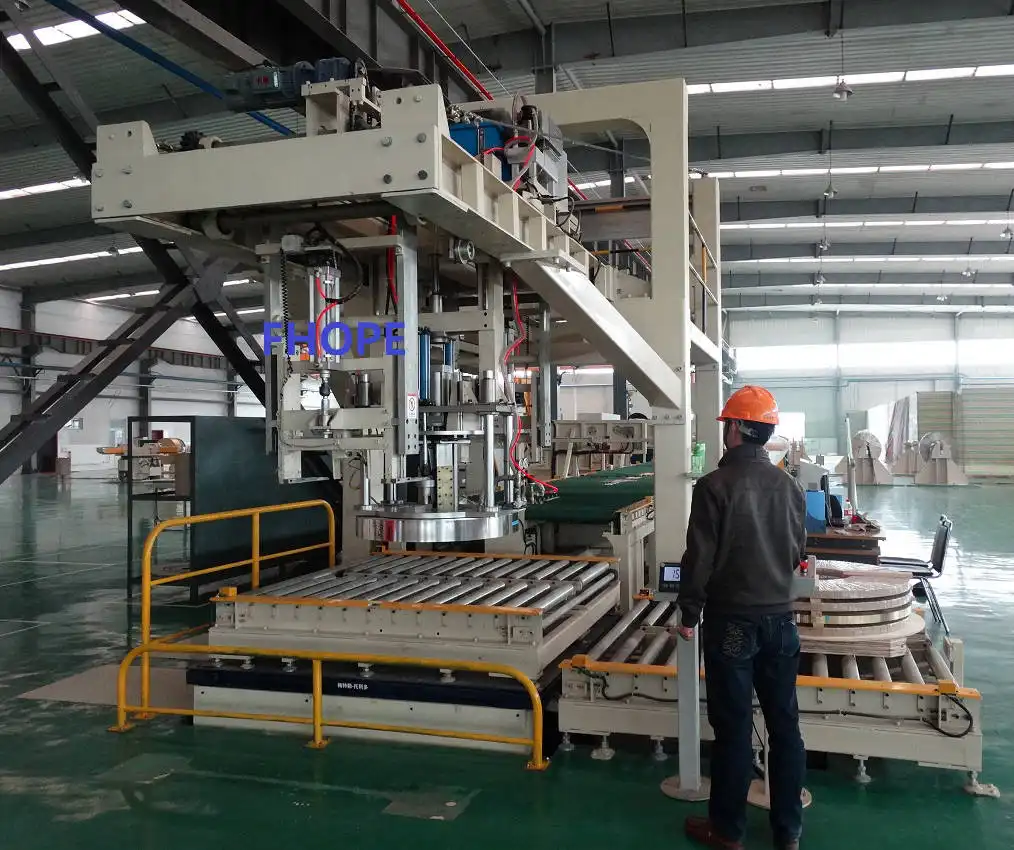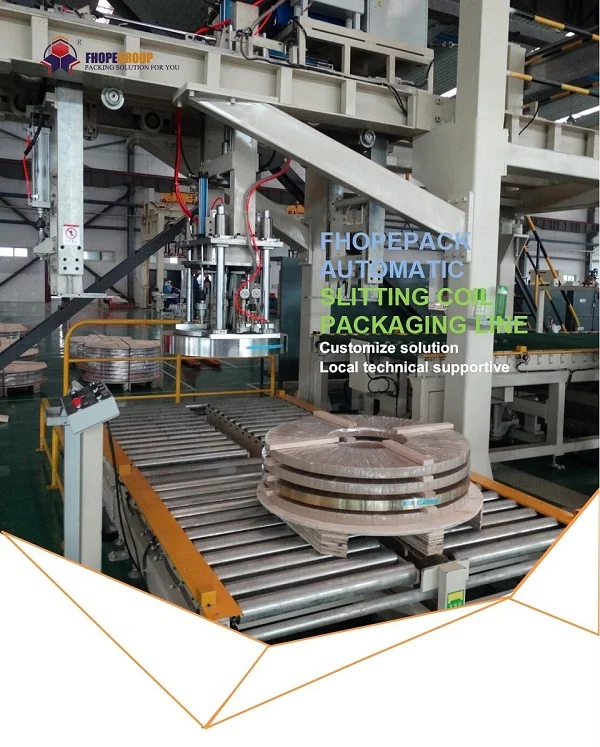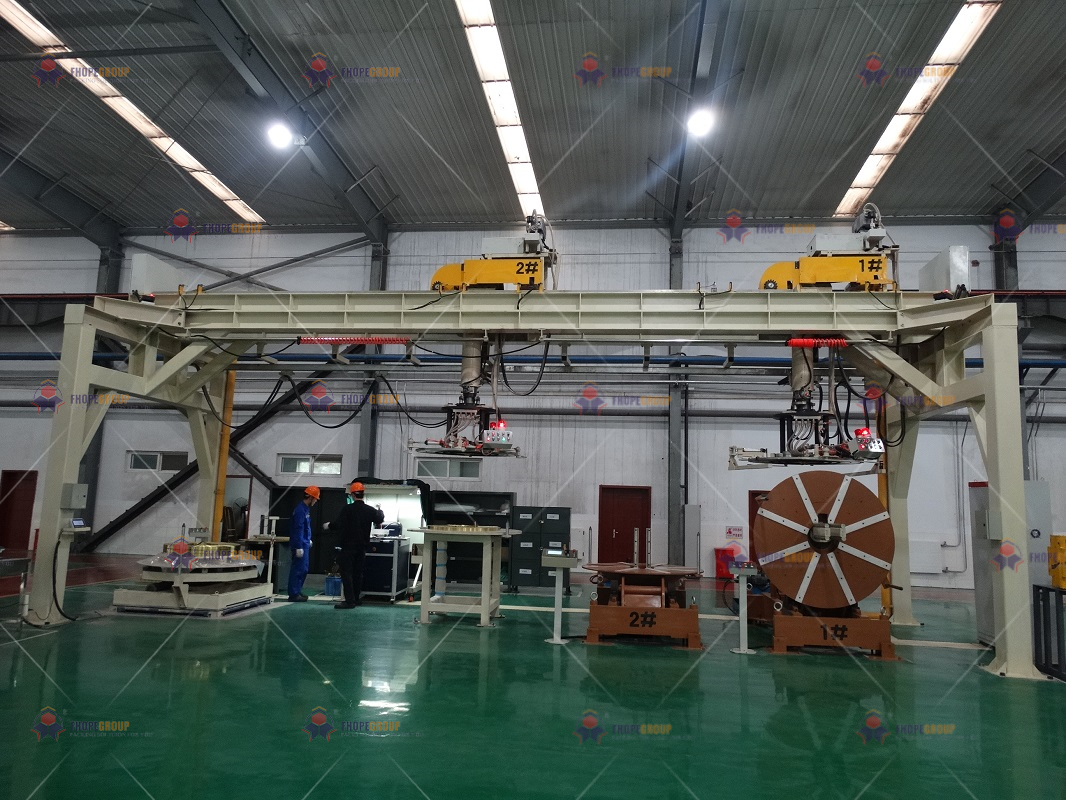Are you the owner of a steel mill, constantly battling rising labor costs and the inconsistencies of manual packing? You see how dependence on manual labor creates bottlenecks, slowing down your entire production line. Every time a worker is absent, makes a mistake, or an accident happens, it puts your product quality and your deadlines at risk. These small issues add up, eating away at your hard-earned profits and causing stress you don't need. It feels like a constant struggle to maintain control. But what if there was a proven way to break free from this cycle? A robust automation solution, already trusted by leading steel mills in Argentina, is designed to give you back that control and transform your packing process from a cost center into a competitive advantage.
Argentina's most trusted coil automation is a fully integrated packing line that handles the entire process, from taking the coil off the turnstile to strapping, wrapping, and palletizing. This system dramatically reduces the need for manual labor, which in turn boosts production speed, eliminates human error, and guarantees consistent, high-quality packaging for every single coil you produce.

You might be thinking that automation sounds like a massive, complex project. You may wonder if it's the right fit for your specific facility, with its unique layout and existing machinery. I understand that concern completely. As an engineer who has spent his entire career on the factory floor, I know that no two mills are the same. That's why this isn't about a one-size-fits-all machine. It's about a tailored solution. Let's break down exactly how this technology addresses the real-world challenges you face every day and how it can be adapted to achieve your specific goals.
How Can Automated Coil Packing Lines Directly Lower Your Operating Costs?
Are your operating costs feeling unpredictable and out of control? You look at your balance sheet and see the impact of labor wages, benefits, and overtime. You see the cost of wasted wrapping materials and the financial hit from coils damaged during manual handling. These expenses are not just numbers; they represent a direct drain on your profitability. A single misplaced forklift tine or a poorly wrapped coil can lead to thousands of dollars in losses and a damaged relationship with a client. You need a solution that brings predictability and control back to your expenses. A well-designed automated packing line isn't just a piece of equipment; it's a strategic tool that provides a clear, measurable path to lower your overall operating costs.
Automated coil packing lines directly lower operating costs by targeting the three biggest areas of expense: labor, materials, and product damage. The system minimizes the need for manual workers in the packing area, which reduces your wage bill and associated costs. It also uses packaging materials with precision, eliminating the waste common in manual wrapping. Finally, its gentle and consistent robotic handling prevents the dents and scratches that lead to costly rework or customer rejection. This combination delivers a rapid and easily calculated return on investment.

A Clear Breakdown of Your Cost Savings
As an engineer and a factory owner myself, I always look at the numbers. A big investment must have a clear and justifiable return. For a CEO like Javier, who conducts rigorous feasibility analyses, the financial case for automation must be undeniable. It’s not about vague promises; it’s about tangible, predictable savings. Let's look at a direct comparison.
| Cost Category | Manual Packing Process | Automated Packing Line |
|---|---|---|
| Labor Costs | High and Variable (3-5 operators per shift) | Minimal (1 supervisor per line) |
| Material Waste | High (15-25% overuse of film/straps) | Negligible (Precise, programmed application) |
| Product Damage Rate | Moderate (1-3% due to human error) | Near Zero (<0.1% due to robotic handling) |
| Downtime | Frequent (Breaks, shift changes, errors) | Minimal (Scheduled maintenance only) |
Let's dive deeper into each of these areas. Labor is more than just a salary. It includes the costs of recruitment, extensive training, insurance, benefits, and potential liability for workplace accidents, which are common in heavy industrial environments. By automating, you re-assign your valuable team members to more strategic roles, reducing direct labor costs in the packing area by up to 80%.
Next, consider material waste. When a worker wraps a coil by hand, they often use more film than necessary "just to be safe." An automated wrapper, however, is programmed to use the exact, optimal amount of material every time. It calculates the surface area and applies the wrap with consistent tension and overlap. This precision can cut your consumption of stretch film and other packing materials by 20% or more, a significant saving that goes directly to your bottom line.
Finally, and perhaps most critically, is product damage. Manual handling with forklifts or cranes is where most damage occurs. A small mistake can lead to a dented coil, which might mean scrapping the product or selling it at a steep discount. An automated system uses smooth, robotic movements. It picks up, moves, and places coils with a precision that humans simply cannot match, day in and day out. This drastically reduces damage rates, protecting your revenue and your reputation for quality.
What Makes a Coil Automation System Truly Reliable for Aging Steel Mills?
You look around your plant and see equipment that has served you well for over 15 years. It's the backbone of your operation, but you know its reliability is decreasing. The idea of introducing a new, complex automation system into this environment is daunting. You worry it won't integrate smoothly with your older machinery. What if the new technology creates new bottlenecks or, even worse, causes more downtime than it saves? The fear of a failed integration project is real. It can disrupt production for weeks and turn a promising investment into a costly mistake. But a truly reliable system isn't just about the latest technology. It’s about smart, robust engineering designed specifically to thrive in demanding environments like yours.
A coil automation system proves its reliability in an aging mill when it is built with three key principles in mind: robust industrial components, a modular design for flexible integration, and smart technology for predictive maintenance. This focus on durability, adaptability, and intelligence ensures the system strengthens your existing production flow instead of clashing with it. It becomes a dependable workhorse that enhances the value of your entire facility.

The Three Pillars of Rock-Solid Reliability
For an experienced leader like Javier, who has risen through the ranks, reliability isn't an abstract concept—it's the foundation of productivity and profitability. When you're responsible for a 2-million-ton-per-year facility, you can't afford to gamble on unproven equipment. That’s why we build our systems not just to work, but to last, especially in environments where machinery has to be tough.
1. Robust Construction and Components
Reliability starts with the materials. We use heavy-gauge structural steel for the frames, oversized motors and gearboxes that operate well below their maximum capacity, and premium components from globally recognized brands like Siemens, Schneider Electric, and SKF. This is crucial. When your maintenance team sees familiar, high-quality components, they have confidence in the system. It means spare parts are accessible, and troubleshooting is straightforward. We over-engineer our machines because we know the conditions in a steel mill are harsh. Dust, temperature fluctuations, and 24/7 operation demand equipment that is built to endure, not just to function.
2. Modular and Adaptable Design
This is the key to integrating new technology into an existing plant. We don't force a "one-size-fits-all" solution. Instead, our systems are modular. This means the automation can be implemented in logical phases. You can start by automating the most labor-intensive or bottleneck-prone part of your process—perhaps the wrapping and strapping station. The system is designed to communicate with your existing upstream and downstream equipment. We use standard communication protocols to ensure our machines can "talk" to your older cranes, turnstiles, or conveyor systems. This phased approach minimizes disruption, allows your team to adapt gradually, and lets you manage your capital investment over time.
3. Smart Integration and Predictive Maintenance
This is where modern technology directly addresses the challenge of aging equipment. Our automation lines are equipped with IoT sensors that monitor the health of critical components in real-time. We track motor temperature, vibration, cycle times, and energy consumption. This data is fed into a simple dashboard. Instead of waiting for a bearing to fail and shut down the line, the system will alert you weeks in advance that its vibration signature has changed. This allows you to schedule maintenance during a planned shutdown. This is the essence of achieving 95% uptime. It's not about hoping things don't break; it's about using data to prevent them from breaking in the first place.
Can a Modern Packing Line Also Help You Meet Environmental and Digital Goals?
As a CEO, you're being pulled in multiple directions. On one side, there are increasing government regulations and market demands for more sustainable, environmentally friendly operations. On the other, there's the urgent need to embrace digital transformation to stay competitive. Both require significant investment and feel like separate, monumental tasks. It can feel like you have to choose between being green and being smart, all while trying to manage a tight budget. What if I told you that a single, strategic investment in your packing line could be a major step forward on both fronts simultaneously?
Yes, a modern coil packing line is a powerful tool for achieving both environmental and digital objectives. Environmentally, its high-efficiency motors reduce energy consumption, and its precise material application cuts down on plastic and paper waste, helping you meet sustainability targets and compliance standards. Digitally, the system is a goldmine of data. Its integrated sensors and control systems provide the real-time information needed to deploy MES and big data platforms, making it a cornerstone of your factory's digital transformation.

The Two-in-One Advantage: Sustainability and Digitalization
For a forward-thinking leader like Javier, who has already implemented projects like waste heat recovery, efficiency is key. An investment should solve multiple problems at once. A modern packing line is a perfect example of this synergy. It’s not just a machine; it’s an intelligent node in your factory's ecosystem.
Let's break down how this works:
| System Feature | Environmental Benefit (Greener) | Digital Benefit (Smarter) |
|---|---|---|
| High-Efficiency Motors & Drives | Uses up to 20% less electricity, directly lowering your carbon footprint and energy costs. | Provides real-time energy consumption data per coil, allowing for precise cost allocation and optimization. |
| Precision Wrapping & Strapping | Eliminates material overuse, reducing plastic/paper waste sent to landfills by over 20%. | Automates consumable inventory tracking; the system can signal the ERP when to reorder materials. |
| Automated Data Logging | Generates accurate reports on material usage and energy consumption for environmental audits. | Creates a rich, detailed dataset for every coil packed (ID, weight, dimensions, time), which feeds directly into your MES. |
| Network Connectivity & Sensors | - | Enables full production visualization on a central dashboard, remote diagnostics, and integration with your entire digital platform. |
This isn't theoretical. For your goal of reducing unit product energy consumption by 10%, optimizing the packing line is a tangible contributor. High-efficiency motors and intelligent sleep modes during idle times make a real difference.
On the digital front, this is where your transformation gains momentum. Deploying an MES or a big data platform is only useful if you have good data to feed it. This packing line provides that data automatically. You can track throughput in real-time, identify minor stoppages before they become major problems, and give your sales team accurate, up-to-the-minute information on when an order will be ready. It transforms your packing area from a "black box" at the end of the line into a fully transparent, data-rich part of your smart factory vision. This single investment moves you closer to your goals for environmental compliance and full production visualization.
Why is a 'Total Solution' Partner More Valuable Than a Simple Machine Supplier in Argentina?
You’ve likely purchased industrial equipment before. Too often, the experience is purely transactional. The supplier sells you a machine, it arrives on a truck, and then you're largely on your own to figure out the complex process of installation, integration, and training. This approach creates huge risks, delays, and hidden costs that were never in the original budget. It leaves you with headaches and a machine that may never perform to its full potential. In a challenging and dynamic market like Argentina, you don't need another box-dropper. You need a strategic partner who is as invested in your success as you are.
A 'Total Solution' partner is far more valuable than a simple machine supplier because they provide comprehensive, end-to-end support that de-risks your investment. This partnership goes beyond the sale to include custom design based on your needs, seamless on-site installation, thorough training for your operators and maintenance teams, and proactive, local after-sales support. This holistic approach guarantees that you achieve the performance, reliability, and return on investment you expect, ensuring your long-term success.

The Critical Difference Between a Supplier and a Partner
This is the core of our philosophy at SHJLPACK and why our slogan is "TOTAL SOLUTION FOR WRAPPING MACHINE." I founded this company based on my own experiences as an engineer on the factory floor. I saw firsthand how the wrong equipment, or even the right equipment without the right support, could cause immense frustration and financial loss. A true partner understands your business, not just their machine.
Here is what that partnership looks like in practice:
Stage 1: Deep Consultation and Custom Design
A supplier shows you a catalog. A partner starts by asking questions. We come to your site. We measure your space. We study your coil types—the widths, the weights, the materials. We talk to your operators and engineers. We want to understand your workflow, your pain points, and your specific goals, like achieving 95% uptime or cutting operational costs by 8%. Only then do we begin designing a solution that is tailored specifically for you. This collaborative process ensures the final system fits your operation like a glove, not an ill-fitting suit.
Stage 2: Transparent Manufacturing and Integration Planning
Throughout the manufacturing process, we provide you with updates. More importantly, we work with your team to plan the integration. We map out exactly how our system will connect mechanically and digitally with your existing infrastructure. This detailed planning, done weeks in advance, is what ensures a smooth and rapid installation process, minimizing disruption to your ongoing production.
Stage 3: On-Site Installation and Comprehensive Training
Our commitment doesn't end when the machine ships. Our own experienced engineers travel to your facility in Argentina for the installation and commissioning. We don't leave until the line is running at peak performance and, crucially, until your team is fully confident in operating and maintaining it. We provide hands-on training for your operators on the user interface and in-depth mechanical and electrical training for your maintenance crew.
Stage 4: Long-Term Local Support and Continuous Improvement
This is what truly separates a partner from a supplier. We establish a local support network to provide fast service and readily available spare parts. Your success is our success. We stay in touch, offering advice and insights as your needs evolve. If you want to integrate new digital tools or adapt the line for a new product two years from now, we are there to help you. This long-term relationship is the foundation of a 'total solution.' It's a promise of shared success.
My Insights: From Engineer to Owner, What I Learned About Trust
I started my career on the factory floor, just like many of your team members. I was an engineer, passionate about making machines run better. I spent years watching plant managers struggle. They would buy a machine from one company, a conveyor from another, and controls from a third, and then spend months trying to force them to work together. The frustration was immense. It was a puzzle with pieces that were never designed to fit.
When I started my own factory, SHJLPACK, I made a promise to myself. I would not just sell machines. I would sell solutions. I would build the kind of company that I, as a young engineer, would have wanted to partner with. A company built on a foundation of shared engineering principles and a deep understanding of the real-world pressures of running a factory.
I look at a profile like Javier's—an engineer by training, a leader who rose through the ranks, and now an owner responsible for the livelihoods of many. I see a person who understands the importance of reliability, efficiency, and return on investment. You appreciate elegant design, but you demand robust performance. You are not looking for a fancy brochure; you are looking for a trustworthy partner who can help solve your challenges. My journey has taught me that trust is not built on a sales pitch. It is built in the details of the engineering, in the honesty of the communication, and in the unwavering support you provide long after the machine is installed. This is my commitment to you.
Conclusion
True coil automation is about more than just machinery. It is about a reliable partnership that reduces costs, boosts efficiency, and secures the future growth of your business.





